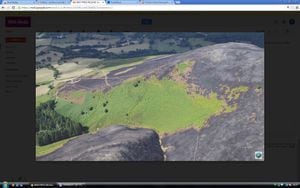Watch: Drone footage reveals devastating damage of fire on Horseshoe Pass
Environmental workers will spend the autumn fully assessing the damage caused to a mountain by a wildfire that raged for a month.

Earlier this summer a fire broke out on the Horseshoe Pass, near Llangollen, with multiple fire crews working around the clock to put it out.
It re-ignited and peat continued to burn, forcing the road over the mountain to be repeatedly closed.
Now Natural Resources Wales has released drone footage showing the extent of the damage from the fire which began in July, at the height of the summer heatwave.
Initial surveys reveal that 247 hectares, the size of about 247 rugby pitches, has been burnt and there is little vegetation left in the area.
The mountain is a Site of Special Scientific Interest for its heather moorland habitats and upland breeding birds and is home to rare birds like the black grouse and the curlew.
It also provides grazing areas for local farmers and is popular with walkers.
NRW worked with North Wales Fire and Rescue Service and Denbighshire Countryside Services to cut back vegetation and create fire breaks to try and stop the fire spreading.
Burnt
Nick Thomas, operations manager for North East Wales, Natural Resources Wales, said: “Mynydd Llantysilio is really important to both people and wildlife and over the last five years we have worked with Denbighshire County Council, local farmers and others to improve the vegetation for wildlife and grazing.
“The thin mineral soil is normally covered by heathland vegetation like heather, bilberry and gorse.
“There are also some pockets of deeper peat that have been particularly badly affected by the fire.
“In places it has been completely burnt away, exposing a sandy sub-soil and rock.
“We anticipate that some heathland plants will grow back from roots that have survived the fire or from the seeds.
“However, the peatland areas are likely to take much longer to re-vegetate and some areas may not recover naturally.”





